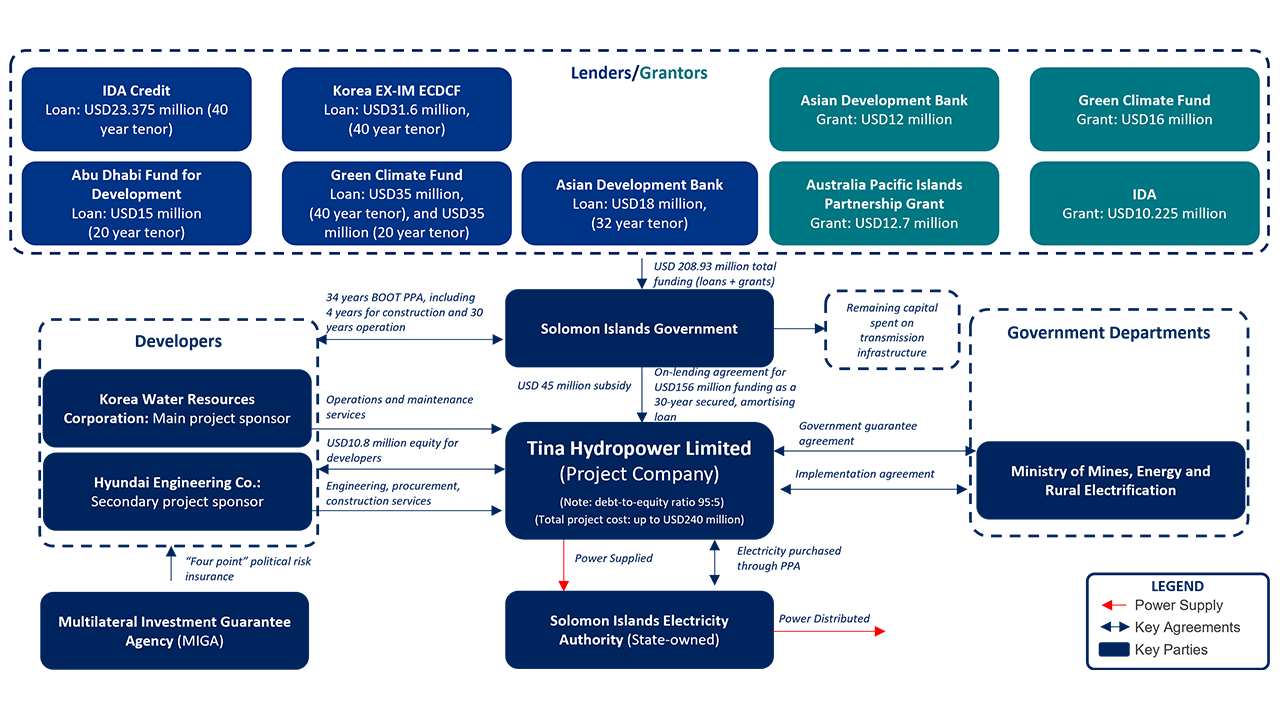Case studies
Publication Date
17 November 2021
Published
17 Nov 2021
Tina River Hydropower
Context
- The Solomon Islands National Development Strategy 2016–2035 called for greater use of renewable energy generation in the medium term, to service both urban and rural demand. It also called for opening the market to independent power providers.
- The Tina River hydropower project includes four components: the hydropower facility, an access road, a transmission line, and technical assistance.
Stakeholders involved
- Public party: Solomon Islands Ministry of Finance and Treasury
- Company: Tina River Hydropower
- Key Lenders and grant providers: Asian Development Bank, Abu Dhabi Fund for Development, Department of Foreign Affairs and Trade (AU), Korea EX-IM Economic Development Cooperation Fund, GCF Facility, and the World Bank
- MIGA also provided non-commercial risk insurance to the private sector
Problem
- Renewable energy projects require high up-front capital costs. In the Pacific region, most attempts to develop large-scale renewable projects had failed, due to a lack of expertise, limited funding, and a focus on energy supply (i.e. fossil fuels) instead of generation.
- Solomon Islands has a near-total reliance on diesel petrol for electricity generation and its production cost of USD0.82/kW is double the Pacific Islands average.
- Annually, the Tina River Hydropower project is expected to displace 78.35 GWh of diesel generation with clean energy.
- Solomon Islands has experienced political instability in recent years, which can deter foreign investment and increase project cost of capital.
- There is Inequality of electricity access, with only 16% of Solomon Islanders having access to the country’s electricity grid.
Innovation
- A total of USD240 million in funding was provided by an international consortium of six financiers, including USD34 million from the World Bank and USD86 million from the Green Climate Fund.
- IFC was the Solomon Islands governments’ transaction adviser for the project, as part of the Pacific Partnership initiative involving Australia and New Zealand.
- Insurance was provided by the IFC’s Multilateral Investment Guarantee Agency (MIGA).
- The project also involves a unique landowner scheme, which shares project royalties with over 4,000 people in communities around the Tina River.
- The on-lending agreement between the Solomon Islands government and Tina River Hydro (Project Company) incorporated all individual DFI requirements.
Timeline

Results and impact
- Once complete, the plant will supply 68% of the electricity for Honiara (the Solomon Islands capital, which has a population of 85,000) with green energy. Previously, only 3% of Honiara’s electricity was from renewable sources. This will help Honiara reduce its reliance on diesel from 97% to around 30% and reduce greenhouse gas emissions by 49,500 tonnes of CO2 per year.
- By replacing some of the diesel generators that previously powered the capital, Tina Hydro will reduce the cost of power and bolster the Solomon Island’s energy independence (it previously imported diesel for electricity generation, making electricity susceptible to price shocks).
- The construction phase of the project is generating 440 local jobs.
- Tina River Hydropower is the first large-scale PPP in the Solomon Islands.
- More affordable, reliable electricity through hydro will allow businesses and households to reinvest electricity cost savings in the economy.
- The project will improve access to electricity, including in rural areas where 80% of the population live.
Key lessons learnt
- In untested markets, private investors and governments can leverage concessional financing from development finance institutions to lower the cost of financing and increase the debt size.
- MIGA may also play an important role in securing this capital by providing political risk insurance for foreign investors, which is important given the history of political instability in the Solomon Islands.
- For renewable energy projects in populated areas, landowner participation schemes can provide valuable local jobs training. Royalty payments and land lease agreements also ensure the sharing of project benefits.
- Hydropower construction helps create energy reservoir capacity, enabling higher PV solar usage and further decreasing reliance on diesel generators for baseload power.

